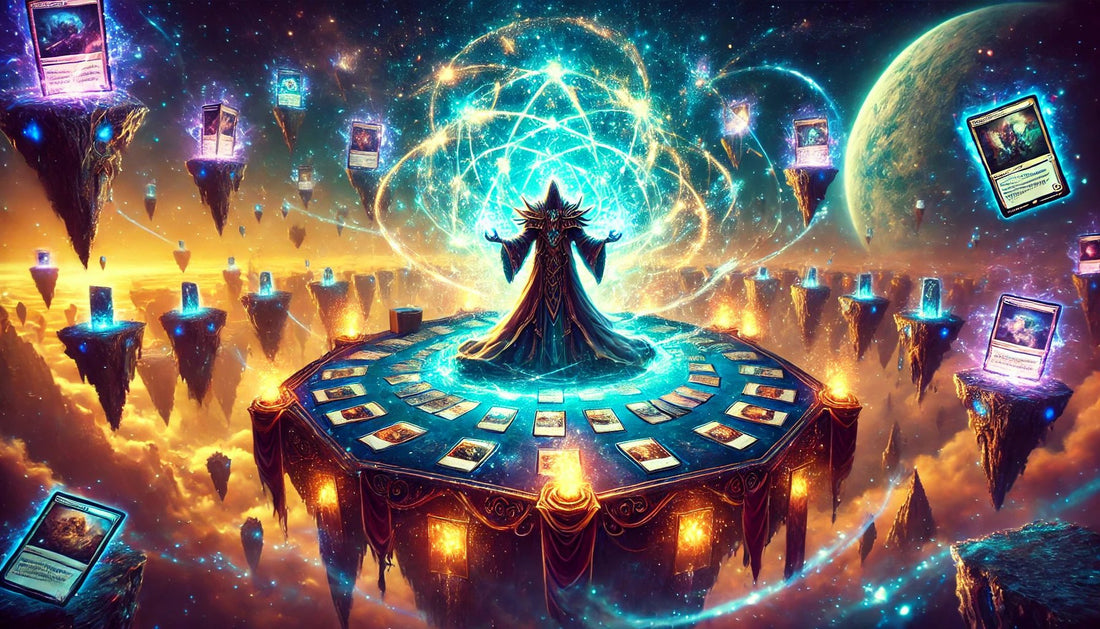
Crafting a Legendary Spellbook: How to Build a Competitive Magic: The Gathering Deck
Share
Introduction: Welcome to the Multiverse
Imagine yourself standing at the edge of the multiverse, gazing at a horizon filled with infinite worlds, each pulsing with magical energy. In your hands, you hold a spellbook—a deck of cards that embodies your power as a planeswalker. With every draw, you tap into the essence of the multiverse, ready to unleash legendary creatures, devastating spells, and cunning strategies upon your foes. But how do you craft a deck that can harness this power effectively? How do you build a deck that not only stands its ground but also dominates the battlefield? Welcome, aspiring archmage, to the art of competitive Magic: The Gathering deck-building.
In this guide, we will embark on a journey to build a deck that not only reflects your unique style but also holds its own in the fiercest of duels. Whether you’re new to the game or looking to refine your skills, this guide will provide you with the knowledge and strategies to forge a deck worthy of any grand tournament.
Chapter 1: The Foundations of a Competitive Deck
Every great deck begins with a strong foundation, much like the ancient fortresses that dot the landscapes of Dominaria. At its core, a deck is a collection of 60 cards (or more in certain formats), each chosen with precision to complement the others. But not all cards are created equal; the key to a competitive deck lies in balance, synergy, and focus.
1.1 Choose Your Colors Wisely Magic: The Gathering revolves around five colors—White, Blue, Black, Red, and Green—each representing a unique philosophy and strategy. The first step in deck-building is to decide which colors will best represent your playstyle. Do you crave control and knowledge? Then Blue might be your path. Or perhaps you revel in destruction and chaos—Red is calling your name. The choice of colors dictates the direction your deck will take, so choose wisely.
1.2 Establishing Your Win Condition Every deck needs a clear path to victory, a goal that guides your card choices and gameplay. This is known as your win condition. It could be overwhelming your opponent with a horde of creatures, depleting their life total with a flurry of direct damage spells, or slowly draining their resources while you build an unstoppable force. Establishing your win condition early helps you stay focused as you select the remaining cards for your deck.
1.3 The Art of Mana Curve Balance is key in any deck, and nowhere is this more apparent than in the mana curve. The mana curve refers to the distribution of spells across various mana costs in your deck. A well-crafted curve ensures that you can play spells effectively throughout the game, from early game threats to late-game finishers. Avoid the pitfalls of being mana-starved or flooded by carefully considering how your cards fit into this curve.
Chapter 2: Synergy and Strategy
With the foundations laid, it’s time to weave the intricate web of synergy that will make your deck truly formidable. Synergy refers to how well your cards work together, creating combinations that are greater than the sum of their parts.
2.1 Finding the Right Combos In Magic, some cards are like puzzle pieces—on their own, they may be strong, but when combined with others, they can become game-changing. Identifying and including these combos in your deck is essential for maximizing its potential. Whether it’s a simple combo like pairing a creature with lifelink with a source of damage to gain life, or a more complex interaction that can lock down your opponent’s strategy, these combos are the key to victory.
2.2 Building Around Key Cards Every deck has its stars—those key cards that your strategy revolves around. These are the cards you’ll want to draw consistently, so your deck should be built to support them. This could mean including card draw spells to find them faster, protection spells to keep them safe, or other cards that enhance their abilities. Building around key cards is like constructing a tower; each piece needs to fit perfectly to reach the top.
2.3 Sideboard Strategy In competitive Magic, your deck is not just the 60 cards you bring to battle—there’s also the sideboard, a reserve of up to 15 cards that you can swap in between games in a match. The sideboard allows you to adapt to your opponent’s strategy, countering their strengths and shoring up your weaknesses. A well-planned sideboard can be the difference between victory and defeat in a tournament.
Chapter 3: The Road to Refinement
Building a deck is just the beginning. Like a finely crafted sword, it must be tested and tempered before it’s ready for battle. This chapter focuses on the process of refining your deck through playtesting, tweaking, and iteration.
3.1 Playtesting and Iteration No deck is perfect right out of the gate. Playtesting is crucial to understanding how your deck performs in different situations and against various opponents. As you play, take note of which cards underperform, which combos are difficult to pull off, and where your deck’s weaknesses lie. Use this information to make adjustments, swapping out cards and refining your strategy until your deck is as sharp as a razor.
3.2 Keeping Up with the Meta The Magic: The Gathering meta—the prevailing trends and strategies in the competitive scene—is constantly evolving. New sets are released, new strategies emerge, and what was once a top-tier deck can quickly fall out of favor. Staying competitive means staying informed. Regularly update your deck to adapt to the current meta, and don’t be afraid to innovate with new cards and strategies.
3.3 The Art of the Sideboard (Revisited) As you refine your deck, your sideboard strategy will also need to evolve. Pay attention to the decks that are popular in the meta and adjust your sideboard accordingly. A well-prepared sideboard can catch your opponents off guard and turn the tide in your favor.
Chapter 4: The Final Battle – Preparing for Tournaments
With your deck finely tuned and your strategy honed, it’s time to step into the competitive arena. Whether you’re entering a local Friday Night Magic event or a large-scale tournament, preparation is key.
4.1 Mental Preparation Building a competitive deck is only half the battle; the other half is mental. Approach each match with focus and confidence, but also with the understanding that losses are part of the learning process. Every duel is a chance to improve, regardless of the outcome.
4.2 Tournament Etiquette Magic: The Gathering is a game of strategy, but also of respect. Understand the rules, be courteous to your opponents, and play with integrity. Remember, every player you face is also a planeswalker on their own journey—treat them as such.
4.3 The Joy of Competition At the end of the day, Magic: The Gathering is a game, and games are meant to be fun. Embrace the thrill of competition, the camaraderie of fellow players, and the magic of the multiverse. Whether you walk away with a trophy or simply with new knowledge and experience, the true victory is in the journey.
Conclusion: Your Legendary Deck Awaits
The journey of building a competitive Magic: The Gathering deck is one of discovery, creativity, and strategy. It’s a process that requires patience, practice, and a touch of magic. As you step into the multiverse with your deck in hand, remember that every duel is an opportunity to grow as a planeswalker. May your draws be lucky, your strategies sound, and your spells devastating. The multiverse awaits—go forth and conquer!
With this guide, you're now equipped to craft a deck that will stand up to any challenge, whether in casual play or the heat of competition. Happy deck-building, and may your spells always find their mark!
